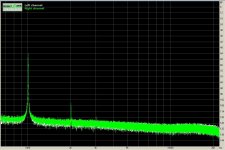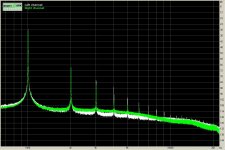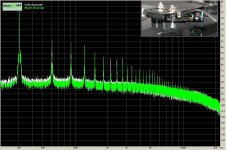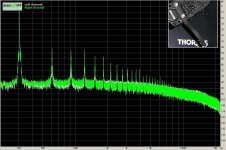Re quality of new an old recordings, this is a sample from 48 years old vinyl
https://www.dropbox.com/s/6ing6d2gkp7klh4/ella_short.wav?dl=0
It is recorded from
http://www.discogs.com/Ella-Fitzger...And-His-Orchestra-Whisper-Not/release/3024689
at 96kHz sampling. Still contains frequencies above 20 kHz. And enjoy dynamics of this stone age record.
Pavel
This ‘above 20kHz content’ in the fr spectrum of a music vinyl playback is not a positive indication of technical superiority when expressed as a generalized comment . I have reasons to say that it is an indication of technical inferiority.
If you play the same vinyl record on a (A) properly adjusted setup with a pristine needle and then on a (B) improperly adjusted setup with a not so pristine needle, you will notice that the spectrum of (B) extends higher than the spectrum of (A).
If the vinyl record is a recording of music, you have no firm standard to form your comparison. You are left with the two fr spectrums and two different sounding recordings.
If the vinyl record is a test tone record, you can see which set up produces the most of the excess frequencies (of harmonic and inharmonic composition).
Besides, mid of sixties wasn’t stone age for vinyl recordings. Even the variable pitch and the transition to stereo cutters were ten years behind.
Only the tracing distortion simulator and the direct to metal mastering were introduced a bit later (end of sixties, beginning of seventies)
But I know you are aware of all these. Just lending a helping hand to redirect the flow of this thread, eh?
George
That's very interesting, George, even if we all know the adjustments should be done correctly.
Regarding the HF content, I suspect I got a taste of that many years ago, when I installed a spare Dual mounting shell with a cartridge supposedly better than mine (LM30 against my LM20). I assumed the owner had done his homework, but it turned out that he hadn't. The result was an odd sound, appearently with more feeling of space up there, but it sounded artificial, as if created by the elctronics rather than actually being there. It sounded so odd to me that I used a Dual supplied protractor and quickly found out that the cartridge had not been installed properly.
And, sure enough, once things were in proper place, the HF sheen (for lack of a better word) was gone. That was the good news, the relatively bad news for my friend was that his LM30 sounded exactly as my LM20, although it was supposed to be better, but it turned out that the stylus shape /mine elliptical, his fine line) didn't really do much except bolstering his ego.
At the tme, I had no measuring gear, so I couldn't follow it up and thus cannot swear it the effect you noted, but I strongly suspect it was something along those lines.
Regarding the HF content, I suspect I got a taste of that many years ago, when I installed a spare Dual mounting shell with a cartridge supposedly better than mine (LM30 against my LM20). I assumed the owner had done his homework, but it turned out that he hadn't. The result was an odd sound, appearently with more feeling of space up there, but it sounded artificial, as if created by the elctronics rather than actually being there. It sounded so odd to me that I used a Dual supplied protractor and quickly found out that the cartridge had not been installed properly.
And, sure enough, once things were in proper place, the HF sheen (for lack of a better word) was gone. That was the good news, the relatively bad news for my friend was that his LM30 sounded exactly as my LM20, although it was supposed to be better, but it turned out that the stylus shape /mine elliptical, his fine line) didn't really do much except bolstering his ego.
At the tme, I had no measuring gear, so I couldn't follow it up and thus cannot swear it the effect you noted, but I strongly suspect it was something along those lines.
There are those who merely stick to known scientific fact of today and then there are those who know now what science will discover later.
Yes, but so many people have an unrealistic idea of what it takes to be or become that person. Even such a person is how they are because they are MORE critical than most, more curious, more clever. They have a knack for learning things that no one else knows or can tell them. A person can spend their life reading books and not achieve this.
Lets not end with unsupported claims and thoughts. I have much simpler explanation, re HF content. Intrinsic + cartridge distortion make products above 20kHz. Take a 16kHz test record and you will see 32kHz 2nd harmonic - always, with any cartridge.
However, there is quite a lot of musical content above 12kHz in the sample I have posted. To verify, just apply sharp DSP high pass filter and then listen to the result.
However, there is quite a lot of musical content above 12kHz in the sample I have posted. To verify, just apply sharp DSP high pass filter and then listen to the result.
Of course, there is no hf wall filter in an analog groove. Just the amount of the treebles is limited by the RIAA curve and the space between adjacent groove.
In practice, we can assure a flat curve up to 20Khz (if the level is not 100%) then a 6db -> 24dB/oct up to 40KHz. It depend of the cutting head, and, of course of your own cartridge. After that, it produce more distortion than useful signal, so we prefer to remove higher HF from the original signal before the cutting process.
No way, as you says, to figure out the useful content measuring the signal when you read the vinyl: you see more the distortion products than the original signal in it
Anyway, who cares about vinyl, when digital can be so transparent comparing to this compilation of noises, scratches, distortions and troubles in the response curves ? Even if some loves the sound produced by a vinyl ?
We can too have nostalgia of the Beatles "Paperback writer" atmosphere, listened on AM radios when we were young ;-) As well.
In practice, we can assure a flat curve up to 20Khz (if the level is not 100%) then a 6db -> 24dB/oct up to 40KHz. It depend of the cutting head, and, of course of your own cartridge. After that, it produce more distortion than useful signal, so we prefer to remove higher HF from the original signal before the cutting process.
No way, as you says, to figure out the useful content measuring the signal when you read the vinyl: you see more the distortion products than the original signal in it
Anyway, who cares about vinyl, when digital can be so transparent comparing to this compilation of noises, scratches, distortions and troubles in the response curves ? Even if some loves the sound produced by a vinyl ?
We can too have nostalgia of the Beatles "Paperback writer" atmosphere, listened on AM radios when we were young ;-) As well.
Last edited:
Pavel,
Your last statement I think is the most glaring reason I think that so many prefer vinyl over digital reproduction, the recording process quality itself and the final result. I think most of us long ago noticed the lack of dynamics on CD when everyone was pushing level to the limits on early recordings and it has now seemed to become the standard of the industry. When people like Christophe worked in recording and vinyl was still the media careful and precise methods created what we all came to expect in dynamics and even microphone techniques. Now I would wonder what the engineers are thinking when they master a recording, is is just that it is so easy to manipulate a digital recording that mike techniques are a lost art, the setup of the musician in a room while recording or many other things that the earlier recording engineers were so careful to get right vs a new crop of engineers saying just get it on digital and we will fix it later?
I don't doubt for a minute that a digital recording can sound as good or better than an earlier vinyl recording but it seems that the quality of the final product has suffered in the fight to have the highest output possible from the digital format. At the same time I would say the same thing about Pop music these days, most singers whether they can sing or not seem to think they have to scream to be heard, I can't stand so many of these singers, especially women screaming at me, I wish someone would tell them to tone it down in the studio so I can actually appreciate their music and not cringe when they yell at me.
Your last statement I think is the most glaring reason I think that so many prefer vinyl over digital reproduction, the recording process quality itself and the final result. I think most of us long ago noticed the lack of dynamics on CD when everyone was pushing level to the limits on early recordings and it has now seemed to become the standard of the industry. When people like Christophe worked in recording and vinyl was still the media careful and precise methods created what we all came to expect in dynamics and even microphone techniques. Now I would wonder what the engineers are thinking when they master a recording, is is just that it is so easy to manipulate a digital recording that mike techniques are a lost art, the setup of the musician in a room while recording or many other things that the earlier recording engineers were so careful to get right vs a new crop of engineers saying just get it on digital and we will fix it later?
I don't doubt for a minute that a digital recording can sound as good or better than an earlier vinyl recording but it seems that the quality of the final product has suffered in the fight to have the highest output possible from the digital format. At the same time I would say the same thing about Pop music these days, most singers whether they can sing or not seem to think they have to scream to be heard, I can't stand so many of these singers, especially women screaming at me, I wish someone would tell them to tone it down in the studio so I can actually appreciate their music and not cringe when they yell at me.
I like that old mastering, quite natural sound. No DSP and no loudness wars. We have transparent digital + horrible mastering practices. Only classical music makes an exception.
There are some very good Jazz and acoustic music recordings as well Pavel.
Yesterday the question was asked about the importance of power supplies in very high quality audio equipment. It would be useful to discuss power supplies for audio circuits.
The short answer is that it can be somewhat to very important, depending on the gain stage being regulated. More details later.
The short answer is that it can be somewhat to very important, depending on the gain stage being regulated. More details later.
I beg to differ in degree, John.
In my book, power supplies vary from very to tremendously important, no less. They are like our onw bloodstream, they feed everything. Who would ask a man with a heart disease to run a marathon?
Their key problem is that they are invisible to the user (buyer), so manufacturers tend to take the way of least reistence and "solve" it all with a cheap capacitor of actually unimpressive size. If it were only that simple.
The worst thing about them is that today they are not treated with half the care they used be, overall. Whoever doubts that, look over the service manuals for models from say second half of the 70ies, the better ones, and just look how they used to do it then. No such lusk or such circuits these days. The full absurdity of this situation is that modern grids are far more polluted than they were then, just count the power gadgets you have today that you didn't have then. Just remember that your average air conditioner has two motors (fan and compressor) on line when it's operational, now multiply by the numer of air cons, than add fridges, dish washing machines, clothes washing machines, microwave ovens, and so forth, and there you have it, doom and gloom in the grid.
In my book, power supplies vary from very to tremendously important, no less. They are like our onw bloodstream, they feed everything. Who would ask a man with a heart disease to run a marathon?
Their key problem is that they are invisible to the user (buyer), so manufacturers tend to take the way of least reistence and "solve" it all with a cheap capacitor of actually unimpressive size. If it were only that simple.
The worst thing about them is that today they are not treated with half the care they used be, overall. Whoever doubts that, look over the service manuals for models from say second half of the 70ies, the better ones, and just look how they used to do it then. No such lusk or such circuits these days. The full absurdity of this situation is that modern grids are far more polluted than they were then, just count the power gadgets you have today that you didn't have then. Just remember that your average air conditioner has two motors (fan and compressor) on line when it's operational, now multiply by the numer of air cons, than add fridges, dish washing machines, clothes washing machines, microwave ovens, and so forth, and there you have it, doom and gloom in the grid.
Intrinsic + cartridge distortion make products above 20kHz. Take a 16kHz test record and you will see 32kHz 2nd harmonic - always, with any cartridge.
That’s it.
2nd & 3rd with any cartridge when reading low modulation velocity tracks (att 1, 1kHz at -20dBu ).
And when reading high mod velocity tracks, harmonic content goes beyond 10th (att 2, 1kHz at ref. 0dBu, i.e. 7cm/sec).
Plus variability among playback equipment can be tremendous. Every component on the TT adds to the signature of sound.
As an example, the following two freq spectrums (att 3, 4) represent the same test track (HFN Test LP Side 1 Track 9, 300Hz +18dB) played back through the same set-up.
The minor change that alters the spectrum is damping of the SME headshell’s handle, which has been covered with thermo-shrink tube .
I like that old mastering, quite natural sound. No DSP and no loudness wars. We have transparent digital + horrible mastering practices. Only classical music makes an exception.
Only classical music makes a consistent exception (regards of the AAD, ADD, DDD labeling)
There are some very good Jazz and acoustic music recordings as well Pavel.
That’s true Bonsai.
Alas these two types of music –Jazz mostly-are suffering brutal mastering intervention lately for to add ‘air’ and ‘atmosphere’ , that’s how they turn as recommended material for Hi-End system reference recordings (OMG).
George
Attachments
Last edited:
I put a lot of effort into making audio power supplies, based on experience, as much as new measurements.
Power supplies differ in noise and transient response. Most IC based power supplies suffer from one or both, yet they can be very valuable in reducing AC ripple, usually better than any other approach.
On the other hand, some circuits have more inherent power supply rejection than others, and I have found this critical in defining what power supply will work most effectively. I have even heard the difference between electrolytic and film for decoupling, and I had to change from one to another, because of this.
Power supplies differ in noise and transient response. Most IC based power supplies suffer from one or both, yet they can be very valuable in reducing AC ripple, usually better than any other approach.
On the other hand, some circuits have more inherent power supply rejection than others, and I have found this critical in defining what power supply will work most effectively. I have even heard the difference between electrolytic and film for decoupling, and I had to change from one to another, because of this.
I like that old mastering, quite natural sound. No DSP and no loudness wars. We have transparent digital + horrible mastering practices. Only classical music makes an exception.
FYI - many new classical music releases suffer from excessive editing these days - cuts, crossfades, pitch shift of individual notes etc.
We had a discussion about this on one of the mastering software lists a few years ago and the number of around 100 edits per minute of material came up !!! Not that it represented the typical case, but nevertheless.
Pavel, thanks for the sample - just had a look and listen, there's a slight peak of energy at 17k and 35k ... what's it coming from? Brickwalled at 16k, high pass; of course, can't hear this on 'rubbish' PC speakers,  , so did a pitch change of down 15 semi-tones, near 60% drop in frequency ...
, so did a pitch change of down 15 semi-tones, near 60% drop in frequency ...
That 16kHz and above sound was then recognisable, it's the overtones, or playback distortion from the strike of the drummer's brushes(?), perfectly keeping the beat.
That 16kHz and above sound was then recognisable, it's the overtones, or playback distortion from the strike of the drummer's brushes(?), perfectly keeping the beat.
What do you mean by "standard suite of tests"?
My standard AP tests are noise, distortion VS level and frequency plus frequency response. Harmonics are part of the distortion. Then the listening test.
The type of circuit is of course a big part specifically supply rejection. This test was done on preamp products with external supplies looking identical. I should dig up the rejected supply and see if better measurements can be made today.
Thanks, wayne. Distortion vs frequency as well? Stability? Any details you could give about the circuit (e.g., PSR)?
I know you know this, but for pedagogical purposes it should be mentioned that power supply issues often show up as sidebands to the test fundamental, e.g., a 1kHz sine will have some sidebands at 1060, 1120, 940, and 880.
I know you know this, but for pedagogical purposes it should be mentioned that power supply issues often show up as sidebands to the test fundamental, e.g., a 1kHz sine will have some sidebands at 1060, 1120, 940, and 880.
For pedagogic purpose, it would be good to remember that some countries exists outside of US. In fact only 43 countries uses 60Hz and all the rest of the world 50but for pedagogical purposes it should be mentioned that power supply issues often show up as sidebands to the test fundamental, e.g., a 1kHz sine will have some sidebands at 1060, 1120, 940, and 880.
Last edited:
Let's start with the beginning history of solid state power supplies.
Back in the 1960's when solid state mostly replaced tubes in both pro and consumer equipment, we usually used a SINGLE supply for the preamp, and sometimes, the amp. For example, Ampex pro audio used a single regulated 28V
supply with both input and output caps in every gain block. Then with the advent of linear IC's, symmetrical power supplies became popular. Originally these were discrete power supplies, for the most part, but there were a few interesting IC DC regulator blocks that became useful.
In a way, some of these early regulators, while being rather effective, were also rather complex in that they took a lot of external parts to make them work properly. That is why 10 years later, the LM317-337 combination was designed, as it had only 3 terminals and could be set with a couple of resistors to a whole range of voltages. There were tradeoffs for this 'simplicity' however. These parts were usually noisier than the very first IC regulators, due to the fact that the early regulators had useful reference cap bypass pins that lowered the regulator noise considerably. No, not to the very lowest level of noise, but useful for general design. So, one of the problems with many IC regulators is that they are too noisy for the application. Secondly, they usually have lousy transient response. This is critical, in my opinion and why I never allow an IC regulator to be connected directly to an audio gain block. What to do? That is next.
Back in the 1960's when solid state mostly replaced tubes in both pro and consumer equipment, we usually used a SINGLE supply for the preamp, and sometimes, the amp. For example, Ampex pro audio used a single regulated 28V
supply with both input and output caps in every gain block. Then with the advent of linear IC's, symmetrical power supplies became popular. Originally these were discrete power supplies, for the most part, but there were a few interesting IC DC regulator blocks that became useful.
In a way, some of these early regulators, while being rather effective, were also rather complex in that they took a lot of external parts to make them work properly. That is why 10 years later, the LM317-337 combination was designed, as it had only 3 terminals and could be set with a couple of resistors to a whole range of voltages. There were tradeoffs for this 'simplicity' however. These parts were usually noisier than the very first IC regulators, due to the fact that the early regulators had useful reference cap bypass pins that lowered the regulator noise considerably. No, not to the very lowest level of noise, but useful for general design. So, one of the problems with many IC regulators is that they are too noisy for the application. Secondly, they usually have lousy transient response. This is critical, in my opinion and why I never allow an IC regulator to be connected directly to an audio gain block. What to do? That is next.
- Status
- Not open for further replies.
- Home
- Member Areas
- The Lounge
- John Curl's Blowtorch preamplifier part II



